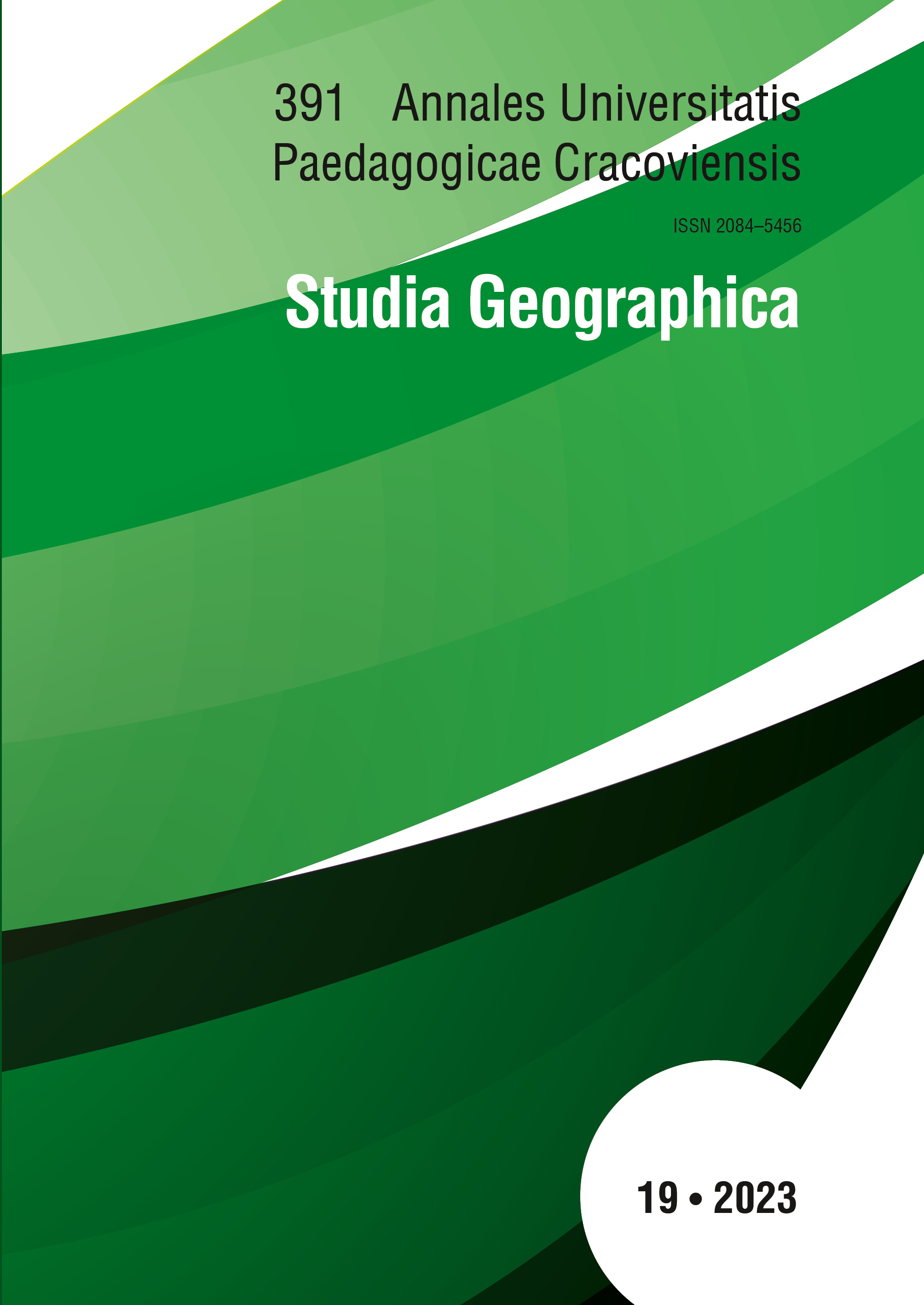Exploratory analysis of health- related indicators contained in the Sustainable Development Goals for the State of Mexico
DOI:
https://doi.org/10.24917/20845456.19.2Słowa kluczowe:
Stan Meksyk, geoinformatyka, wskaźniki związane ze zdrowiem, Cele Zrównoważonego RozwojuAbstrakt
Cele zrównoważonego rozwoju związane ze zdrowiem (SDGs) stanowią kluczowe wskaźniki służące do oceny stanu zdrowia, samopoczucia i ogólnego rozwoju populacji danego kraju. Niniejsze badanie ma na celu szczegółowe zbadanie dostępnych wskaźników SDGs dla stanu Meksyk na poziomie gminnym, wykorzystując zaawansowane techniki zakorzenione w eksploracyjnej analizie przestrzennej danych. Głównym celem jest wszechstronne zrozumienie wzajemnych zależności tych wskaźników i ich geograficznego rozkładu. Ten podejście analityczne ujawni widoczne wzorce obejmujące skupiska, rozproszenie, przestrzenną samokorelację i inne tendencje geograficzne w wybranych wskaźnikach. Samokorelacja przestrzenna odgrywa kluczową rolę w wykrywaniu podobieństw lub rozbieżności w wartościach oraz ich potencjalnej korelacji z bliskością geograficzną. Analiza ta służy ustaleniu istnienia istotnych wzorców przestrzennych. Aby to osiągnąć, wykorzystane zostaną narzędzia graficzne, takie jak mapy i diagramy. Te wizualne reprezentacje efektywnie przekazują informacje geograficzne, ułatwiając komunikację wyników. Metoda ta będzie szczególnie wartościowa w identyfikacji podatnych grup ludności. Przewidywane rezultaty obejmują solidne wyniki, które znacząco mogą wpłynąć na agendy rozwojowe i wytyczanie polityki zdrowotnej w meksykańskim regionie.
Bibliografia
Anselin, L., (1995). Local Indicators of Spatial Association—LISA. Geographical Analysis, 27(2), 93–115.
Anselin, L. (1999). The Future of Spatial Analysis in the Social Sciences. Geographic Information Sciences, 5(2), 67–76. DOI: 10.1080/10824009909480516.
Asma S., Lozano R., Chatterji S., et al. (2020). Monitoring the health- related Sustainable Development Goals: lessons learned and recommendations for improved measurement. Lancet, 395(10219), 240–246. DOI: 10.1016/S0140-6736(19)32523–1
Breilh, J. (2003). Epidemiología crítica: ciencia emancipadora e interculturalidad. Buenos Aires : Lugar Editorial .
Buzai, G., Baxendale, C. (2012). Sociospatial analysis with geographic information systems. Volume 2: Territorial planning thematic vactorial. Editorial Site
García, N., Tello P. (2020). Geographic Guerrero State Assessment: An Approximation based on socioeconomic factors vulnerability mycos. In: Santana et al. (coord). Ordinationón territorial: A review from the Sustainable Development Goals (First editionón, pp. 133–160). Toluca, México: Aut University of State of México. http://ri.uaemex.mx/handle/20.500.11799/109169
GBD 2015 SDG Collaborators (2016). Measuring the health- related Sustainable Development Goals in 188 countries: a baseline analysis from the Global Burden of Disease Study 2015. Lancet, 388(10053), 1813–1850. DOI: 10.1016/S0140-6736(16)31467–2
Gross Domestic Product by State 2020. Press Release Nom727/2021’. Inegi. December 9, 2021. Retrieved 16 September 2022. Available in: Press release. Gross Domestic Product by State 2020 (inegi.org.mx)
Íñiguez L., Barcellos, C. (2003). Geography and health in Latin America: evolution and trends. Cuban Journal of Public Health, 29(4) Retrieved October 09, 2023, http://scielo.sld.cu/scielo.php?script=sci_arttext&pid=S0864-34662003000400007&lng=es&tlng=es
Mitchell, A., (200). Esri’s Guide to GIS Analysis. Vol. 2, Esri Press, 5
Novillo-Ortiz, D., Quintana, Y., Holmes J.H., et al. (2021). Leveraging data and information systems on the sustainable development goals. International Journal of Medical Informatics, 152(104504). DOI: 10.1016/j.ijmedinf.2021.104504
Porto- Gonçalves C.W. (2002). Da geografia às geo-grafias: um mundo em busca de novas territorialidades. In: Ceceña A.E., Sader E. (eds.), Infinite War: Hegemony and World Terror. Buenos Aires: Latin American Council of Social Sciences, p. 217–256.
Santana G., Aguilar A.G. (2019). Method for spatial autocorrelation (Application to homicide mortality in the State of Mexico). Posted in Quantitative Methods in Human Geography. Ed. Buzai G. and Santana M.V. Available in: http://ri.uaemex.mx/bitstream/handle/20.500.11799/100130/2019%20Indicadores%20aplicaci%C3%B3n%20a%20la%20microplaneaci%C3%B3n.pdf?sequence=1&isAllowed=y
Siabato W., Guzmán J. (2019). Spatial autocorrelation and the development of quantitative geography. Cuadernos de Geografía: Revista Colombiana de Geografía, 28(1), 1–22. DOI: 10.15446/rcdg.v28n1.76919
United Nations. (2020). Do you know all 17 SDGs? [Online] Retrieved 01 August 2022, https://sdgs.un.org/goals#history
United Nations. (2022). Goal 3: Ensure healthy lives and promote well- being for all at all ages [Online] Retrieved on 05 August 2022 https://www.un.org/sustainabledevelopment/es/health/
Wilson, G.M., Ball, M.J., Szczesny, P., Haymann, S., Polyak, M., Holmes, T., & Silva, J.S. (2021). Health Intelligence Atlas: A Core Tool for Public Health Intelligence. Applied Clinical Informatics, 12(4), 944–953. DOI: 10.1055/s-0041-1735973
World Health Organization (2020). Global Health Statistics 2020: Monitoring Health for the SDGs [Online] Retrieved on 01 August 2022, https://apps.who.int/iris/handle/10665/338072
Pobrania
Opublikowane
Numer
Dział
Licencja
Prawa autorskie (c) 2024 Annales Universitatis Paedagogicae Cracoviensis Studia Geographica

Utwór dostępny jest na licencji Creative Commons Uznanie autorstwa – Bez utworów zależnych 4.0 Międzynarodowe.
Złożenie artykułu do druku oznacza wyrażenie zgody na bezpłatne (tj. bez honorariów autorskich) przeniesienie autorskich praw majątkowych na Wydawcę i zezwolenie na wydanie pracy w postaci drukowanej w dowolnej liczbie egzemplarzy oraz zamieszczenie jej w postaci otwartego dostępu na stronie internetowej czasopisma, w bibliotekach cyfrowych oraz innych cyfrowych platformach wydawniczych, z którymi Wydawca zawarł lub zawrze stosowne porozumienie o udostępnianiu. W przypadku artykułów wieloautorskich przyjmuje się, że autor zgłaszający pracę („correspondingauthor”) ma pełnomocnictwo do reprezentowania pozostałych współautorów w tym zakresie. Autorzy są proszeni o podpisanie stosownego oświadczenia w tej sprawie.

